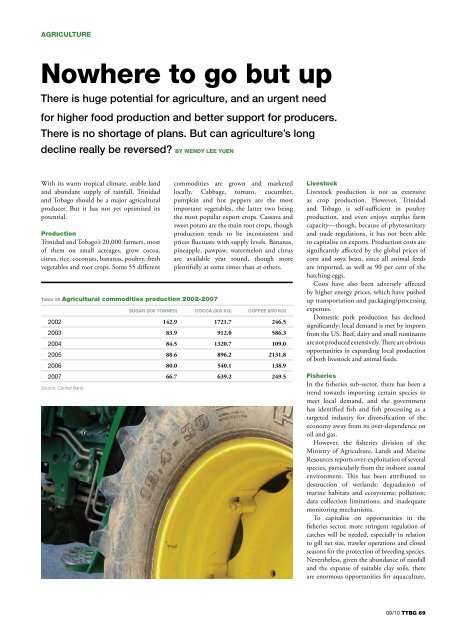The Trinidad & Tobago Business Guide (TTBG, 2009-10)
- No tags were found...
You also want an ePaper? Increase the reach of your titles
YUMPU automatically turns print PDFs into web optimized ePapers that Google loves.
AGRICULTURE<br />
Nowhere to go but up<br />
<strong>The</strong>re is huge potential for agriculture, and an urgent need<br />
for higher food production and better support for producers.<br />
<strong>The</strong>re is no shortage of plans. But can agriculture’s long<br />
decline really be reversed? By Wendy Lee Yuen<br />
With its warm tropical climate, arable land<br />
and abundant supply of rainfall, <strong>Trinidad</strong><br />
and <strong>Tobago</strong> should be a major agricultural<br />
producer. But it has not yet optimised its<br />
potential.<br />
Production<br />
<strong>Trinidad</strong> and <strong>Tobago</strong>’s 20,000 farmers, most<br />
of them on small acreages, grow cocoa,<br />
citrus, rice, coconuts, bananas, poultry, fresh<br />
vegetables and root crops. Some 55 different<br />
Table 28 Agricultural commodities production 2002-2007<br />
commodities are grown and marketed<br />
locally. Cabbage, tomato, cucumber,<br />
pumpkin and hot peppers are the most<br />
important vegetables, the latter two being<br />
the most popular export crops. Cassava and<br />
sweet potato are the main root crops, though<br />
production tends to be inconsistent and<br />
prices fluctuate with supply levels. Bananas,<br />
pineapple, pawpaw, watermelon and citrus<br />
are available year round, though more<br />
plentifully at some times than at others.<br />
SUGAR (000 TONNES) COCOA (000 KG) COFFEE (000 KG)<br />
2002 142.9 1721.7 246.5<br />
2003 83.9 912.0 586.3<br />
2004 84.5 1320.7 <strong>10</strong>9.0<br />
2005 88.6 896.2 2131.8<br />
2006 80.0 540.1 138.9<br />
2007 66.7 639.2 249.5<br />
Source: Central Bank<br />
Livestock<br />
Livestock production is not as extensive<br />
as crop production. However, <strong>Trinidad</strong><br />
and <strong>Tobago</strong> is self-sufficient in poultry<br />
production, and even enjoys surplus farm<br />
capacity—though, because of phytosanitary<br />
and trade regulations, it has not been able<br />
to capitalise on exports. Production costs are<br />
significantly affected by the global prices of<br />
corn and soya bean, since all animal feeds<br />
are imported, as well as 90 per cent of the<br />
hatching eggs.<br />
Costs have also been adversely affected<br />
by higher energy prices, which have pushed<br />
up transportation and packaging/processing<br />
expenses.<br />
Domestic pork production has declined<br />
significantly; local demand is met by imports<br />
from the US. Beef, dairy and small ruminants<br />
are not produced extensively. <strong>The</strong>re are obvious<br />
opportunities in expanding local production<br />
of both livestock and animal feeds.<br />
Fisheries<br />
In the fisheries sub-sector, there has been a<br />
trend towards importing certain species to<br />
meet local demand, and the government<br />
has identified fish and fish processing as a<br />
targeted industry for diversification of the<br />
economy away from its over-dependence on<br />
oil and gas.<br />
However, the fisheries division of the<br />
Ministry of Agriculture, Lands and Marine<br />
Resources reports over-exploitation of several<br />
species, particularly from the inshore coastal<br />
environment. This has been attributed to<br />
destruction of wetlands; degradation of<br />
marine habitats and ecosystems; pollution;<br />
data collection limitations; and inadequate<br />
monitoring mechanisms.<br />
To capitalise on opportunities in the<br />
fisheries sector, more stringent regulation of<br />
catches will be needed, especially in relation<br />
to gill net size, trawler operations and closed<br />
seasons for the protection of breeding species.<br />
Nevertheless, given the abundance of rainfall<br />
and the expanse of suitable clay soils, there<br />
are enormous opportunities for aquaculture,<br />
09/<strong>10</strong> <strong>TTBG</strong> 69


















